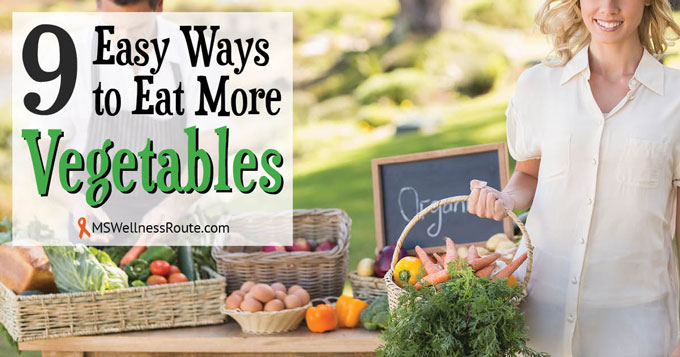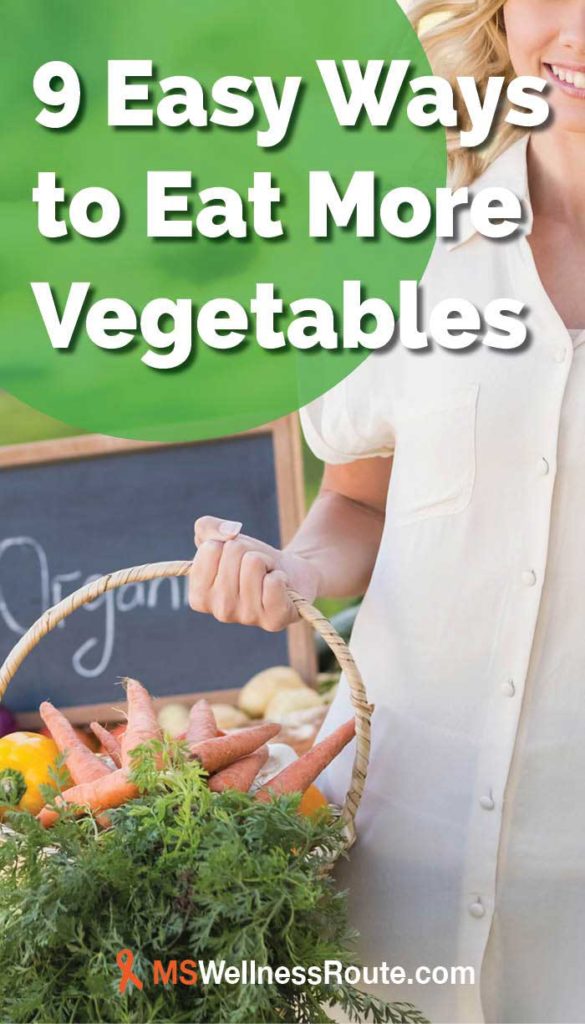Last Updated on January 30, 2025 by Cathy

It doesn’t matter which diet you’re on, Paleo, Wahls, or ketogenic diet for multiple sclerosis (MS). What does matter is the number of vegetables you are eating every day. According to the USDA’s MyPlate, we should be eating 2.5 cups of vegetables each day. Unfortunately, only one in ten Americans meet this recommendation.
Researchers discovered people with MS have lower levels of important nutrients. It’s unclear if MS causes the deficiencies or the other way around. It’s known that gut bacteria play a huge role in MS and people with MS usually have a poor gut microbiome. Plus, they recently discovered that gut bacteria cause inflammation in the brain.
If you are living with MS it’s time to adopt a healthy diet and increase your vegetables to get more nutrients. Dr. Terry Wahls, in her book The Wahls Protocol, recommends 6-9 cups depending on your size. Even six cups of vegetables may sound overwhelming when you are starting. But it’s not that hard once you get the hang of it.
I was already on the Paleo diet when the book The Wahls Protocol book came out. When I read that you had to eat 9 cups of vegetables a day, my first thought was – how am I going to do that? It’s funny when you look back and see how easy it really is. The trick is adding vegetables to EVERYTHING!
Get Your Free Guide to Fruits and Vegetables at the bottom of this post!
Easy ways to eat more vegetables:
1. Salad
The easiest way to add more vegetables is by eating a salad. Not an iceberg salad with a few tomatoes and dressing on top. I’m talking about a BIG salad, one that fills your plate. When I was younger I hated salads because they had no flavor. Today I love salads with different varieties of vegetables and seasonings.
Enjoy my Big Healthy Salad:
- Dark leafy greens like arugula, kale, Swiss chard, and watercress, OR buy an organic salad mix.
- Broccoli (I steam them first) or broccoli sprouts
- Cauliflower (I steam them first)
- Cucumber slices
- Parsley
- Red onion
- Avocado
- Garlic, minced
- Nuts, raw (only a few), or seeds like flaxseeds (high in omega-3)
- Drizzled with lemon juice or extra virgin olive oil as the dressing
- Topped off with homemade sauerkraut (you can also buy Bubbies) or kimchi
Then top the salad with seasonings such as oregano, turmeric, and/or fresh ground pepper. I know this sounds weird but I’ve even put cinnamon on my salads. Cinnamon helps control blood sugar which is helpful when trying to control candida.
2. Smoothies
Drink a green smoothie, and play around with different vegetables. If you’re just starting out you may need more fruit, I drink a green smoothie without fruit every day. You can read one of my favorite recipes here Super Nutrient-Dense Green Smoothie. Another one of my favorite smoothies with fruit is Easy Power Green Smoothie.
3. Soup
Soups are an excellent way to get more vegetables into your diet. I like to make a big pot with whatever vegetables I have in the refrigerator. Then slow cook it in bone broth with seasonings. Add chicken for protein or make my delicious Paleo Clam Chowder.
If I’m after a creamy soup I add a can of full-fat coconut milk. Soup is great for any meal or any time of year. Leftover soup makes a great breakfast when you’re in a hurry to get out the door.
4. Lettuce Wrap
Instead of a sandwich with bread try a lettuce wrap. Our son is a type 1 diabetic so we got really good at making lettuce wraps. I found green and red leaf lettuce works pretty well compared to romaine. To get started, grab some parchment instead of aluminum foil to help hold your wrap together. You don’t want heavy metals touching your food.
Line your surface with parchment paper, leaving about 2 inches on each end. You want it longer than the lettuce leaves. Use large lettuce leaves and smashed avocado on top as your spread.
For the meat use ground beef, ground turkey, shredded chicken, or lunch meat from Applegate. For the meat use ground beef, ground turkey, shredded chicken, or lunch meat from Applegate.
Add vegetables like red cabbage, shredded carrots, onions, fermented pickles, and seasonings. Add whatever vegetables your heart desires.
5. Spiral-cut Vegetables
You don’t have to miss your favorite pasta dishes, use vegetables instead. With a spiralizer, you can use nutrient-dense vegetables instead of pasta. You can spiralize beets, carrots, sweet potatoes, and zucchini. Check out my Creamy Chicken “Zoodle” Soup recipe.
6. Cauliflower
Cauliflower is very versatile, you can eat it alone, in soups, casseroles, and as rice or as a pizza crust. To make it, pulse the florets in a food processor or high-speed blender into small granules. Then substitute it for rice. I also like to use coconut aminos as a substitute for soy sauce for my Asian meals.
7. Add Vegetables to Meat
Another great way to get more vegetables into your diet is by adding them to your meat dishes. Try adding vegetables like garlic, onions, and spinach mixed in with your next meat dish. You can even use “cauliflower rice” or “broccoli rice” mixed in with your meat. Check out my Spinach Turkey Burgers recipe.
8. Frozen Vegetables
Don’t forget about frozen vegetables. They are often frozen immediately so you won’t be missing any nutrients. They are affordable, convenient, and won’t go bad quickly like fresh vegetables.
Serve them as a side dish and add some seasonings or use them for stir-fries, soups, or stews. Keep several bags in the freezer. There have been many times I haven’t made it to the store for more fresh veggies and the frozen vegetables came in handy.
Quick Links To Information In This Post:
9. Plant Your Own Garden
It is fun and rewarding to pick vegetables you grew from your own garden. You don’t even need a large plot of land, container gardening works just as well. I’ve grown peppers, tomatoes, cucumbers, and broccoli in containers.
Start with easy-to-grow vegetables like dark leafy greens, carrots, cucumbers, onions, radishes, and zucchini. It’s very easy to eat more vegetables when fresh veggies are growing in your own garden.
Get Your Free Guide to Fruits and Vegetables below!
As you can see there are many easy ways you can add more vegetables to your diet. As you eat vegetables as a regular part of your diet, you will increase your antioxidants, fiber, and nutrients. Which is something we all need to live healthily.
Get Your Free Guide to Fruits and Vegetables
Get the password for my library including the Guide to Fruits and Vegetables here by filling out this form:
Want to remember this? Pin it to your favorite Pinterest board!


9 Easy Ways to Eat More Vegetables





